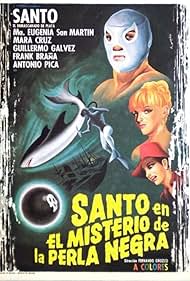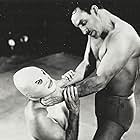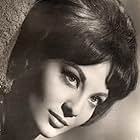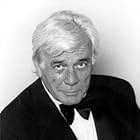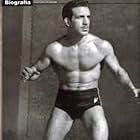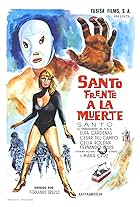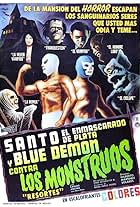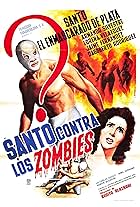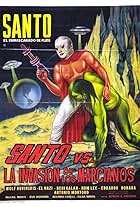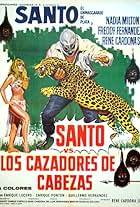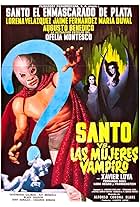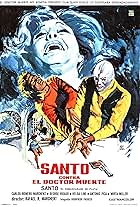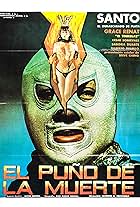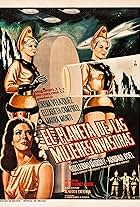IMDb RATING
4.4/10
37
YOUR RATING
Santo faces thugs, death and betrayal as he chases jewel thieves across South America.Santo faces thugs, death and betrayal as he chases jewel thieves across South America.Santo faces thugs, death and betrayal as he chases jewel thieves across South America.
Photos
- Director
- Writer
- All cast & crew
- Production, box office & more at IMDbPro
Storyline
Featured review
Santo is informed about a plot to smuggle a set of stolen diamonds - attached to the outer hull of a cruise ship - to Panama where they're exchanged for pearls . But the baddies (Frank Braña, Mara Cruz , Antonio Pica) behind the operation listen in on the briefing and from now on make every attempt to keep Santo from getting onto the cruiser but without success . Likewise on the cruise ship many attempts are made to kill Santo , as along the way , he suffers attacks , assaults and betrayal . When he leaves the ship in Panama , Santo runs into a trap and he's ultimately tied to a post beneath the pier where he's to be drowned once the tide comes in , but an unknown man saves him the last minute. Santo shows up at exactly the restaurant baddie Andres (Antonio Pica) and his entourage companions , giving them quite a fright, and gets a message via throwing knife to meet one Wu-Li (María Eugenia San Martín), who results to be one of Andres' girls who has decided to switch sides, and who has actually seen to it that he got saved from drowning. Wu-Li gives Santo the basics of Andres' plot , and Santo is soon on the trail of Andes' partner , shady pearl dealer Davila (Guillermo Gálvez), who likes to work his native pearl divers , and who shoots dead those who don't execute his orders and thus is almost lynched by the locals . But Santo is taken prisoner and locked-up in prison at Panama fortress , then he makes a hasty getaway , with Santo in hot pursuit , and pretty much leads Santo to Andres , but there's nothing to actually pin on Andres, so he, his girlfriend (Mara Cruz) and Wu-Li make it onwards on the cruise ship with the case of diamonds still attached to the outer hull. But of course, justice is served to them in the end .
A run-of-the-mill Santo movie with noisy action , adventures , thrills , silly fights and a lot of wrestling as male and female . Stars El Santo who faces off various villains played by Spanish actors. Being a Spanish/Mexican co-production , here shows up some familar faces from the Sixties and Seventies that appeared in all kinds of Eurotrash sub-genres , such as : Frank Braña , Mara Cruz and Antonio Pica . Standing out the spectacular and ordinary combats among hunk male-female wrestlers and one of the most successful scenes was probably the catfight among various she-fighters at the ring . Shot on natural locations in Cartagena, Panama , Maracaibo, San Juan de Puerto Rico and Barcelona. ¨Santo en el Misterio de la Perla Negra¨ is actually not one of the better Santo movies that were shot a large number , this film's very straight-forward story , including a lot of flaws , shortfalls, and gaps . Not only does it seem to use a Santo-double in an ill-fitting mask in a handful of scenes , something that's painfully obvious even to the untrained eye, it's also a bit of a hodgepodge of a film . Being lousily filmed by director Fernando Orozco ; besides, it's a film that's really rather sloppily made lacking proper structure, which results in quite some plotholes , shortcomings, flops and leaps of reason by inserting non-sense stock footage from other movies . For its opening scenes, a car chase that doesn't have anything to do with the movie's plot ; later on , a women's wrestling bout is shown that remains completely inconsequential, as well as scenes from an old-fashioned musical revue with explosive girls in peacock outfits , and rather obviously stock footage dating from much earlier than the rest of the film . This of course is objectively not good shooting but is also kind of endearing in its brashness , so certainly adds to the movie's strange charm . But still, as far as Santo movies go, this isn't a nice one , just a somewhat sympathetic oddity . It's rather likely this film was shot at the same time with 1969's ¨Santo Frente a la Muerte¨, since it sharing much cast and crew suggests the two films were filmed back-to-back , something that's only reconfirmed by the fact that some footage of Santo en el Misterio de la Perla Negra also shows up in the non-Santo movie Campeones del Ring from 1972.
El Santo character is actually based on a true person : Rodolfo Guzmán Huerta (1917 -1984), known profesionally as El Santo or in English The Saint, was a Mexican Luchador enmascarado , actor and folk hero. In 1952, the artist and editor José Cruz started a Santo comic book, turning Santo into the first and foremost character in Mexican popular literature, his popularity only rivalled in the 1960s by the legendary Kalimán character. The Santo comic book series ran continuously for 35 years, ending in 1987. Also in 1952, a superhero motion picture serial was made entitled The Man in the Silver Mask, which was supposed to star Santo, but he declined to appear in it, because he thought it would fail commercially. The film was made instead with well-known luchador El Médico Asesino in the lead role, wearing a white mask similar to Santo's silver one. A villain named "The Silver-Masked Man" was introduced into the plot at the last minute, thus the title of the film strangely became a reference to the villain, not the hero. In 1958, Fernando Osés, a wrestler and actor, invited Santo to work in movies, and although Santo was unwilling to give up his wrestling career, he accepted, planning to do both at the same time. Oses was planning on playing the hero in these two films, with Santo appearing as his costumed sidekick, "El Enmascarado". Fernando Osés and Enrique Zambrano wrote the scripts for the first two movies, el Cerebro del Mal (The Evil Brain) and Hombres Infernales, both made in 1958, and directed by Joselito Rodríguez. Filming was done in Cuba, and ended just the day before Fidel Castro entered Havana and declared the victory of the revolution. Santo played a masked superhero-type sidekick to the main hero (who was called El Incognito) in these two films, and was not the main character . The films apparently could not find a distributor for several years. Santo's film career really took off in 1961 with his third movie "Santo vs The Zombies." Santo was given the starring role with this film, and was shown for the first time as a professional wrestler moonlighting as a superhero. When Santo's film career took off in 1961, the producers of the first two films slyly entered Santo's name into the titles and finally got them released. Santo eventually wound up appearing in 52 lucha libre films in all (two of which were just cameo appearances). The style of the movies was essentially the same throughout the series, with Santo as a superhero fighting supernatural creatures, evil scientists, various criminals/ secret agents and so on. The tones were reminiscent of U. S. B-movies and TV shows, perhaps most similar to the old Republic Pictures serials of the 1940s. Many of the later films depicted Santo in simulated sex scenes during which he continued to wear the mask. His best-known movie outside of Mexico is also considered one of his best, 1962's Santo vs. Las Mujeres Vampiro (Santo vs. The Vampire Women), which was also featured in an episode of Mystery Science Theater 3000 .In this movie, the production values were better, and there was an attempt at creating more of a mythos and background for Santo, as the last of a long line of superheroes. It was an enormous success at the box office. Only four of the 52 Santo films were ever dubbed into English, the other 48 being only available in Spanish. The English-dubbed Mexican films of that time period were imported to the United States through the efforts of K. Gordon Murray who changed the name of Santo to "Samson" for some of his releases. Most of Murray's imported Mexi-films went directly to late-night American TV. Santo's most financially successful film was The Mummies of Guanajuato (1970), which co-starred Blue Demon and Mil Mascaras. The Santo film series inspired the production of similar series of movies starring other well-known luchadores such as Blue Demon, Mil Mascaras, Superzan, and the Wrestling Women , among others. Santo even co-starred with Blue Demon and Mil Mascaras in several of his movies. When Blue Demon invited Santo to co-star with him and Mil Mascaras in the "Champions of Justice" movie trilogy, however, Santo was too busy making other films to participate. By 1977, the masked wrestler film craze had practically died off, but Santo continued to appear in more films over the next few years. His last film was Fury of the Karate Experts, shot in Florida in 1982, the same year he retired from the ring. Seventeen years after Santo's death, his real-life son played the lead role in a brand new Santo movie called Infraterrestre (2001), which co-starred Mexican wrestler Blue Panther.
A run-of-the-mill Santo movie with noisy action , adventures , thrills , silly fights and a lot of wrestling as male and female . Stars El Santo who faces off various villains played by Spanish actors. Being a Spanish/Mexican co-production , here shows up some familar faces from the Sixties and Seventies that appeared in all kinds of Eurotrash sub-genres , such as : Frank Braña , Mara Cruz and Antonio Pica . Standing out the spectacular and ordinary combats among hunk male-female wrestlers and one of the most successful scenes was probably the catfight among various she-fighters at the ring . Shot on natural locations in Cartagena, Panama , Maracaibo, San Juan de Puerto Rico and Barcelona. ¨Santo en el Misterio de la Perla Negra¨ is actually not one of the better Santo movies that were shot a large number , this film's very straight-forward story , including a lot of flaws , shortfalls, and gaps . Not only does it seem to use a Santo-double in an ill-fitting mask in a handful of scenes , something that's painfully obvious even to the untrained eye, it's also a bit of a hodgepodge of a film . Being lousily filmed by director Fernando Orozco ; besides, it's a film that's really rather sloppily made lacking proper structure, which results in quite some plotholes , shortcomings, flops and leaps of reason by inserting non-sense stock footage from other movies . For its opening scenes, a car chase that doesn't have anything to do with the movie's plot ; later on , a women's wrestling bout is shown that remains completely inconsequential, as well as scenes from an old-fashioned musical revue with explosive girls in peacock outfits , and rather obviously stock footage dating from much earlier than the rest of the film . This of course is objectively not good shooting but is also kind of endearing in its brashness , so certainly adds to the movie's strange charm . But still, as far as Santo movies go, this isn't a nice one , just a somewhat sympathetic oddity . It's rather likely this film was shot at the same time with 1969's ¨Santo Frente a la Muerte¨, since it sharing much cast and crew suggests the two films were filmed back-to-back , something that's only reconfirmed by the fact that some footage of Santo en el Misterio de la Perla Negra also shows up in the non-Santo movie Campeones del Ring from 1972.
El Santo character is actually based on a true person : Rodolfo Guzmán Huerta (1917 -1984), known profesionally as El Santo or in English The Saint, was a Mexican Luchador enmascarado , actor and folk hero. In 1952, the artist and editor José Cruz started a Santo comic book, turning Santo into the first and foremost character in Mexican popular literature, his popularity only rivalled in the 1960s by the legendary Kalimán character. The Santo comic book series ran continuously for 35 years, ending in 1987. Also in 1952, a superhero motion picture serial was made entitled The Man in the Silver Mask, which was supposed to star Santo, but he declined to appear in it, because he thought it would fail commercially. The film was made instead with well-known luchador El Médico Asesino in the lead role, wearing a white mask similar to Santo's silver one. A villain named "The Silver-Masked Man" was introduced into the plot at the last minute, thus the title of the film strangely became a reference to the villain, not the hero. In 1958, Fernando Osés, a wrestler and actor, invited Santo to work in movies, and although Santo was unwilling to give up his wrestling career, he accepted, planning to do both at the same time. Oses was planning on playing the hero in these two films, with Santo appearing as his costumed sidekick, "El Enmascarado". Fernando Osés and Enrique Zambrano wrote the scripts for the first two movies, el Cerebro del Mal (The Evil Brain) and Hombres Infernales, both made in 1958, and directed by Joselito Rodríguez. Filming was done in Cuba, and ended just the day before Fidel Castro entered Havana and declared the victory of the revolution. Santo played a masked superhero-type sidekick to the main hero (who was called El Incognito) in these two films, and was not the main character . The films apparently could not find a distributor for several years. Santo's film career really took off in 1961 with his third movie "Santo vs The Zombies." Santo was given the starring role with this film, and was shown for the first time as a professional wrestler moonlighting as a superhero. When Santo's film career took off in 1961, the producers of the first two films slyly entered Santo's name into the titles and finally got them released. Santo eventually wound up appearing in 52 lucha libre films in all (two of which were just cameo appearances). The style of the movies was essentially the same throughout the series, with Santo as a superhero fighting supernatural creatures, evil scientists, various criminals/ secret agents and so on. The tones were reminiscent of U. S. B-movies and TV shows, perhaps most similar to the old Republic Pictures serials of the 1940s. Many of the later films depicted Santo in simulated sex scenes during which he continued to wear the mask. His best-known movie outside of Mexico is also considered one of his best, 1962's Santo vs. Las Mujeres Vampiro (Santo vs. The Vampire Women), which was also featured in an episode of Mystery Science Theater 3000 .In this movie, the production values were better, and there was an attempt at creating more of a mythos and background for Santo, as the last of a long line of superheroes. It was an enormous success at the box office. Only four of the 52 Santo films were ever dubbed into English, the other 48 being only available in Spanish. The English-dubbed Mexican films of that time period were imported to the United States through the efforts of K. Gordon Murray who changed the name of Santo to "Samson" for some of his releases. Most of Murray's imported Mexi-films went directly to late-night American TV. Santo's most financially successful film was The Mummies of Guanajuato (1970), which co-starred Blue Demon and Mil Mascaras. The Santo film series inspired the production of similar series of movies starring other well-known luchadores such as Blue Demon, Mil Mascaras, Superzan, and the Wrestling Women , among others. Santo even co-starred with Blue Demon and Mil Mascaras in several of his movies. When Blue Demon invited Santo to co-star with him and Mil Mascaras in the "Champions of Justice" movie trilogy, however, Santo was too busy making other films to participate. By 1977, the masked wrestler film craze had practically died off, but Santo continued to appear in more films over the next few years. His last film was Fury of the Karate Experts, shot in Florida in 1982, the same year he retired from the ring. Seventeen years after Santo's death, his real-life son played the lead role in a brand new Santo movie called Infraterrestre (2001), which co-starred Mexican wrestler Blue Panther.
Details
- Release date
- Countries of origin
- Language
- Also known as
- El misterio de la perla negra
- Filming locations
- Production company
- See more company credits at IMDbPro
Contribute to this page
Suggest an edit or add missing content

Top Gap
By what name was Santo in the Mystery of the Black Pearl (1976) officially released in Canada in English?
Answer